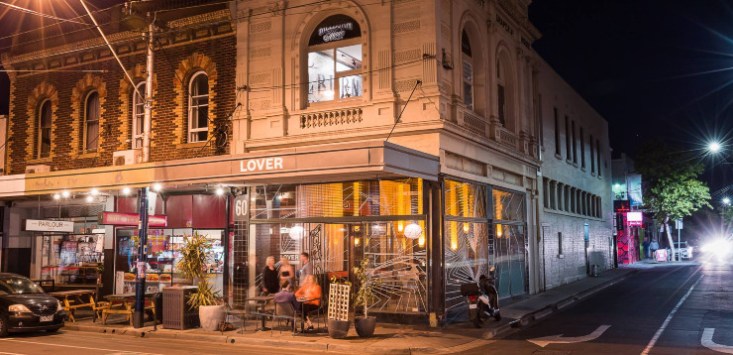
The outside of Lover on Chapel Street.
Melbourne business owner Will Newton found out yesterday that his bar and restaurant Lover will remain closed to indoor diners for at least another two months, as Victorian Premier Daniel Andrews outlining a “safe and steady” plan to reopen the state.
With Newton’s turnover already down 90% in recent months amid Victoria’s business-crushing stage four COVID-19 restrictions, the news is another “distressing” chapter in the roller coaster ride that is trading through a pandemic.
But after a false-start reopening earlier this year, the Chapel Street business owner remains hopeful the latest plan will be the first step towards a return to some semblance of normal.
“[The roadmap] is distressing news, but it wasn’t unexpected, to be honest,” Newton tells SmartCompany.
“Whether you agree with Daniel Andrews or you don’t agree with Daniel Andrews, I think everything he says is absolutely correct.
“He’s not being unreasonable. We need to be able to do it safely.
“Stopping and starting again is a huge stress on businesses, especially small businesses like mine.”
Under a reopening roadmap outlined by the Victorian government on Sunday, hospitality businesses won’t be able to open their indoor dining rooms until at least November 23, after there are no cases recorded in Victoria for 14 consecutive days.
Businesses will be allowed to open for outdoor dining much sooner — after October 26, conditional on fewer than five new cases being recorded over two weeks.
Now that concrete case thresholds are on the table, Newton is clear on what the hospitality industry’s priorities should be in the coming months, with the prospect of councils closing roads to facilitate outdoor dining a potential saving grace for many.
“Hopefully this will provide my industry with a little bit of a wake-up call. We don’t have to stand here and wait for Daniel Andrews to give us a roadmap handout,” Newton says.
“We need to go away as an industry and consolidate everything that held us back when we relaunched last time.
“If we lose Chapel Street’s diversity because all the little guys fall off and only the big guys are left, we’ve lost 10 years of development in our area,” Newton says.
The Restaurant & Catering Association is currently negotiating plans with the state government to open up roads, laneways and other public infrastructure for businesses to utilise — a solution that’s already helping businesses revive their trade in Europe.
The plan would likely see restaurants able to place tables on closed roads and laneways, allowing those without existing outdoor dining infrastructure to partially reopen.
Nothing has been finalised yet, but Newton is putting his hand up to be first in line, saying his venue is adjacent to a one-way street with two lanes.
“It’s a fantastic spot to give it a crack,” he says.
The alternative is another two months of takeaway-only, which isn’t sustainable for Lover, as it has gone down to operating just one night a week recently.
“During the first [lockdown] we were able to keep our whole kitchen on … since then we’ve been in-and-out, and takeaway has completely gone through the tube,” Newton says.
“It’s not worth it anymore.”
NOW READ: Explained: What businesses need to know about Melbourne’s re-opening roadmap
NOW READ: Explained: What businesses need to know about the regional Victoria re-opening roadmap


COMMENTS
SmartCompany is committed to hosting lively discussions. Help us keep the conversation useful, interesting and welcoming. We aim to publish comments quickly in the interest of promoting robust conversation, but we’re a small team and we deploy filters to protect against legal risk. Occasionally your comment may be held up while it is being reviewed, but we’re working as fast as we can to keep the conversation rolling.
The SmartCompany comment section is members-only content. Please subscribe to leave a comment.
The SmartCompany comment section is members-only content. Please login to leave a comment.